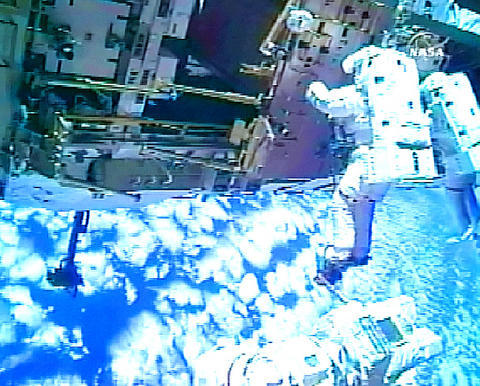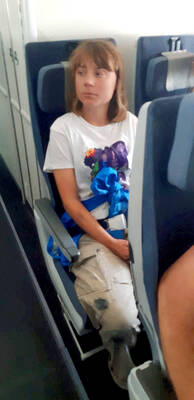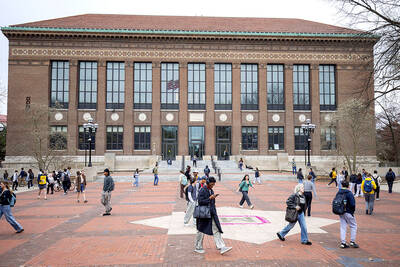An astronaut's ripped glove forced an early end to a spacewalk and added to NASA's headaches as shuttle managers put off a decision on whether to order risky spacewalk repairs for a deep gouge on Endeavour's belly.
After nearly a week of agonizing over the gouge, NASA indicated it was close to wrapping up tests and would decide yesterday whether repairs were needed.
Endeavour's commander, Scott Kelly, asked Mission Control which way managers were leaning. The reply: "Unfortunately, we have no idea which way the wind is blowing at the moment." Later, the chairman of the mission management team told reporters that he remained "cautiously optimistic" repairs would not be needed, based on preliminary test results.

PHOTO: AP
One of the astronauts who would attempt those repairs, Rick Mastracchio, had to cut his latest spacewalk short on Wednesday after he noticed a hole in his left glove.
The 640mm rip in the thumb penetrated only the two outer layers of the five-layer glove, and he was never in any danger, officials said. Nevertheless, he was ordered back inside early as a precaution, and his spacewalking partner quickly finished what he was doing and followed him in.
NASA's spacewalk office manager, Steve Doering, said he would not want to proceed with another spacewalk until the glove problem is better understood. He expected to gather more information over the coming day.
This is the second time in three shuttle missions that a glove has been damaged during a spacewalk at the international space station. Engineers are uncertain whether sharp station edges are to blame or whether it's wear-and-tear.
John Shannon, the mission management team's chairman, said the glove problem would not prevent him from ordering spacewalk repairs for the gouge.
"If we decided we needed to go do this, I would feel very comfortable doing it. We've done a lot of spacewalks without any glove problems," Shannon said.
He added that the repair job would not be anywhere near where Mastracchio was on Wednesday.
The unprecedented patching job on Endeavour, if approved, would be performed on the next spacewalk, now set for tomorrow, a day later than originally planned to give engineers more time to analyze the situation. That could keep Endeavour and its crew of seven, including teacher-astronaut Barbara Morgan, at the space station at least an extra day.
The 9cm-long, 5cm-wide gouge -- the result of a debris strike at liftoff -- is in two of the thousands of black tiles that cover Endeavour's belly and guard against the more than 1,000oC atmospheric re-entry temperatures. Part of the gouge, a narrow one-inch strip, cuts all the way through the tiles, exposing the thin felt fabric that serves as the final thermal barrier to the ship's aluminum frame.
The exposed area and the gouge itself are so small that NASA is not worried about a Columbia-type catastrophe at flight's end. The space shuttle Columbia was destroyed in 2003 when hot atmospheric gases seeped into a hole in its wing and melted the wing from the inside out.
Rather, the concern is that if too much heat enters the crevice, the underlying aluminum structure might be damaged enough to warrant lengthy post-flight repairs. That, in turn, could lead to future launch delays and disrupt space station construction.

Swedish campaigner Greta Thunberg was deported from Israel yesterday, the Israeli Ministry of Foreign Affairs said, the day after the Israeli navy prevented her and a group of fellow pro-Palestinian activists from sailing to Gaza. Thunberg, 22, was put on a flight to France, the ministry said, adding that she would travel on to Sweden from there. Three other people who had been aboard the charity vessel also agreed to immediate repatriation. Eight other crew members are contesting their deportation order, Israeli rights group Adalah, which advised them, said in a statement. They are being held at a detention center ahead of a

A Chinese scientist was arrested while arriving in the US at Detroit airport, the second case in days involving the alleged smuggling of biological material, authorities said on Monday. The scientist is accused of shipping biological material months ago to staff at a laboratory at the University of Michigan. The FBI, in a court filing, described it as material related to certain worms and requires a government permit. “The guidelines for importing biological materials into the US for research purposes are stringent, but clear, and actions like this undermine the legitimate work of other visiting scholars,” said John Nowak, who leads field

Former Nicaraguan president Violeta Chamorro, who brought peace to Nicaragua after years of war and was the first woman elected president in the Americas, died on Saturday at the age of 95, her family said. Chamorro, who ruled the poor Central American country from 1990 to 1997, “died in peace, surrounded by the affection and love of her children,” said a statement issued by her four children. As president, Chamorro ended a civil war that had raged for much of the 1980s as US-backed rebels known as the “Contras” fought the leftist Sandinista government. That conflict made Nicaragua one of

NUCLEAR WARNING: Elites are carelessly fomenting fear and tensions between nuclear powers, perhaps because they have access to shelters, Tulsi Gabbard said After a trip to Hiroshima, US Director of National Intelligence Tulsi Gabbard on Tuesday warned that “warmongers” were pushing the world to the brink of nuclear war. Gabbard did not specify her concerns. Gabbard posted on social media a video of grisly footage from the world’s first nuclear attack and of her staring reflectively at the Hiroshima Peace Memorial. On Aug. 6, 1945, the US obliterated Hiroshima, killing 140,000 people in the explosion and by the end of the year from the uranium bomb’s effects. Three days later, a US plane dropped a plutonium bomb on Nagasaki, leaving abut 74,000 people dead by the